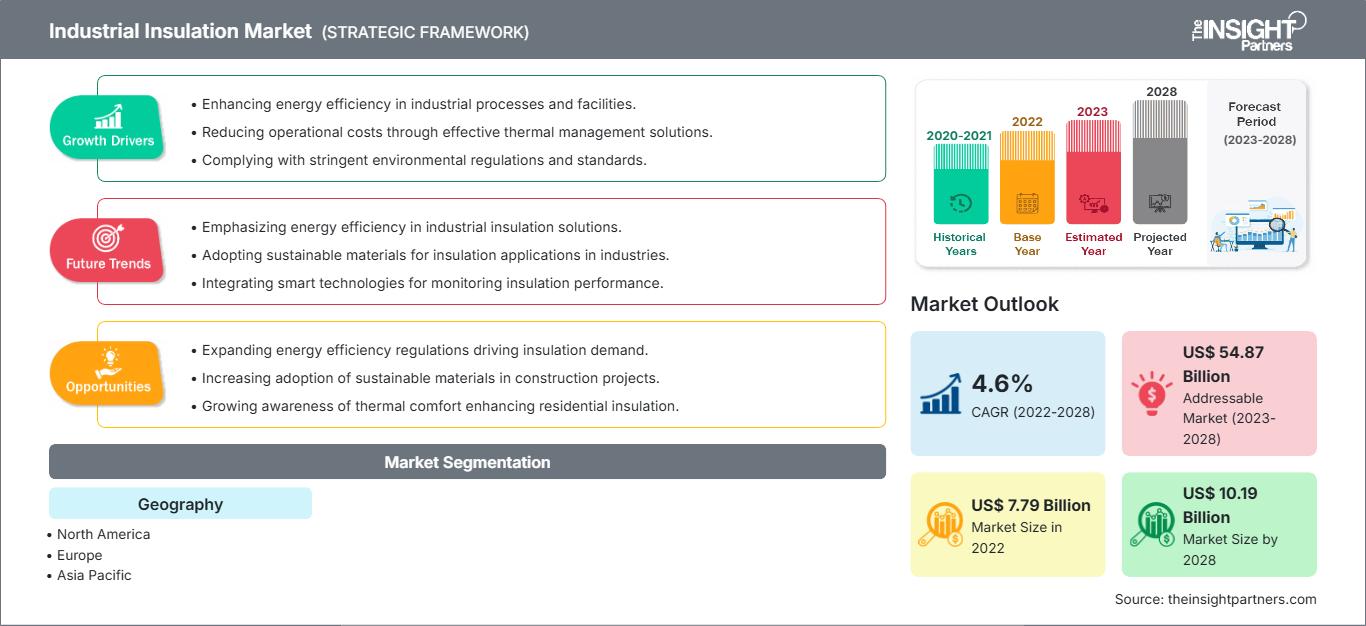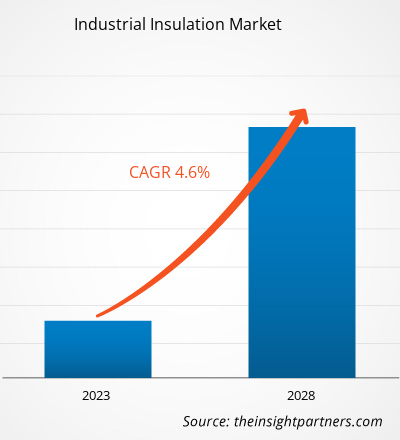[Forschungsbericht] Der Markt für Industrieisolierung wird voraussichtlich von 7.793,91 Millionen US-Dollar im Jahr 2022 auf 10.189,11 Millionen US-Dollar im Jahr 2028 wachsen; von 2022 bis 2028 wird mit einer durchschnittlichen jährlichen Wachstumsrate von 4,6 % gerechnet.
MARKTANALYSE
Industrieisolierung spielt in verschiedenen Branchen eine wichtige Rolle, nämlich in der Stromerzeugung, der Chemie- und Petrochemie-, Zement- sowie der Lebensmittel- und Getränkeindustrie. Industrieisolierung ist in verschiedenen Wasserkraftwerken von großer Bedeutung, da sie den Dampfkesseln hilft, das Temperaturniveau aufrechtzuerhalten. Darüber hinaus werden erhöhte Infrastrukturausgaben in Schwellenländern voraussichtlich lukrative Möglichkeiten für das Marktwachstum im Prognosezeitraum bieten. Mit der Zunahme der Bautätigkeit in verschiedenen Ländern weltweit steigt die Nachfrage nach Industrieisolierung. Der Einsatz von Industrieisolierung in der Infrastruktur schützt vor Hitze, Feuer und Korrosion.
WACHSTUMSTREIBER UND HERAUSFORDERUNGEN
Die strengen weltweiten Vorschriften zur Verwendung von Dämmstoffen zur Energieeinsparung haben das Marktwachstum für Industrieisolierung gefördert. Dämmstoffe verhindern Wärmefluss und tragen zur Senkung der Heiz- und Kühlkosten bei. Strenge Vorschriften zur obligatorischen Verwendung von Dämmstoffen zur Energieeinsparung sind der Hauptfaktor für das Wachstum des Marktes für Industrieisolierung. Energiesparvorschriften und der Bedarf an Dämmstoffen in Endverbrauchsindustrien wie Öl und Gas, Chemie und Petrochemie sowie Lebensmittel und Getränke treiben das Marktwachstum an. Die von verschiedenen Verbänden, nämlich der American Society of Mechanical Engineers (ASME), der American Boiler Manufacturers Association (ABMA) und der American Society for Testing and Materials (ASTM), festgelegten Standards gelten für die Konstruktion von Geräten in der Industrie, um Sicherheitsprotokolle umzusetzen und so das Wachstum des Marktes für Industrieisolierung zu fördern. Die hohen Installationskosten für Industrieisolierung stellen eine Herausforderung für den Markt für Industrieisolierung dar. Die Kosten für die Installation von Industriedämmungen variieren je nach Art, Ausführung, Größe und Komplexität. Die Installation von Industriedämmungen ist ein komplexer Prozess und erfordert moderne Werkzeuge und Arbeitsabläufe. Darüber hinaus ist eine technisch geschulte Person erforderlich, um die Größe der Anlage, die zu isolierende Fläche und das Dämmmaterial zu beurteilen. Die Installation schwerer Dämmstoffe wie Mineralwolle, Schaumstoffplatten und Glasfaser erfordert zudem qualifiziertes Fachpersonal, was die Kosten der Industrieinstallation zusätzlich erhöht.
Passen Sie diesen Bericht Ihren Anforderungen an
Sie erhalten kostenlos Anpassungen an jedem Bericht, einschließlich Teilen dieses Berichts oder einer Analyse auf Länderebene, eines Excel-Datenpakets sowie tolle Angebote und Rabatte für Start-ups und Universitäten.
Markt für industrielle Isolierungen: Strategische Einblicke

- Holen Sie sich die wichtigsten Markttrends aus diesem Bericht.Dieses KOSTENLOSE Beispiel umfasst Datenanalysen, die von Markttrends bis hin zu Schätzungen und Prognosen reichen.
Sie erhalten kostenlos Anpassungen an jedem Bericht, einschließlich Teilen dieses Berichts oder einer Analyse auf Länderebene, eines Excel-Datenpakets sowie tolle Angebote und Rabatte für Start-ups und Universitäten.
Markt für industrielle Isolierungen: Strategische Einblicke

- Holen Sie sich die wichtigsten Markttrends aus diesem Bericht.Dieses KOSTENLOSE Beispiel umfasst Datenanalysen, die von Markttrends bis hin zu Schätzungen und Prognosen reichen.
SEGMENTIERUNG UND UMFANG DES BERICHTS
Die „Globale Marktanalyse für industrielle Isolierung bis 2030“ ist eine spezialisierte und detaillierte Studie mit Schwerpunkt auf globalen Markttrends und Wachstumschancen. Der Bericht soll einen Überblick über den globalen Markt mit detaillierter Marktsegmentierung nach Rohstoff, Produkt, Endverbraucher und Geografie geben. Der globale Markt für industrielle Isolierung hat in der jüngsten Vergangenheit ein hohes Wachstum erlebt und dieser Trend dürfte sich im Prognosezeitraum fortsetzen. Der Bericht liefert wichtige Statistiken zum weltweiten Verbrauch von industrieller Isolierung sowie zur Nachfrage in wichtigen Regionen und Ländern. Darüber hinaus bietet der Bericht eine qualitative Bewertung verschiedener Faktoren, die die Marktleistung für industrielle Isolierung in wichtigen Regionen und Ländern beeinflussen. Der Bericht enthält auch eine umfassende Analyse der führenden Akteure auf dem Markt für industrielle Isolierung und ihrer wichtigsten strategischen Entwicklungen. Es sind auch mehrere Analysen der Marktdynamik enthalten, um die wichtigsten Antriebsfaktoren, Markttrends und lukrativen Gelegenheiten zu identifizieren, die wiederum bei der Identifizierung der wichtigsten Einnahmequellen helfen.
Darüber hinaus bieten die Ökosystemanalyse und die Fünf-Kräfte-Analyse von Porter eine 360-Grad-Ansicht des globalen Marktes für industrielle Isolierung, die dabei hilft, die gesamte Lieferkette und die verschiedenen Faktoren zu verstehen, die das Marktwachstum beeinflussen.
SEGMENTANALYSE
Der globale Markt für industrielle Isolierung ist nach Rohstoff, Produkt und Endverbraucher segmentiert. Basierend auf dem Rohstoff ist der Markt für industrielle Isolierung in Wolle, Schaumstoffe und Fasern und Sonstiges unterteilt. Auf der Grundlage des Produkts ist der Markt in Rohre, Platten, Decken und Sonstiges unterteilt. Der Markt für industrielle Isolierung ist auf der Grundlage des Endverbrauchers in Energieerzeugung, Chemie und Petrochemie, Zement, Lebensmittel und Getränke und Sonstiges kategorisiert. Auf der Grundlage des Rohstoffs machte der Schaumstoffrohstoff einen erheblichen Anteil aus. Glasfaserwolle wird durch Erhitzen von Glas bis zum Schmelzen hergestellt. Das geschmolzene Glas wird anschließend schnell verdreht, um Fasern zu bilden. Glaswollefasern werden anschließend miteinander verbunden und dienen als Dämmung. Glasfasern bilden Lufteinschlüsse, die Wärmeverluste verhindern, da Luft ein schlechter Wärmeleiter ist. Schaumdämmstoffe sind Polymerprodukte, die häufig für verschiedene Zwecke wie Wärmedämmung, Schalldämmung und Wetterschutz eingesetzt werden. Zu den Fasern gehören Natur-, Synthetik- und Kunststofffasern. Keramikfasern und recycelte Plastikflaschen (aus PET) werden hauptsächlich für industrielle Dämmungszwecke verwendet. Die daraus hergestellten Fasern werden zu Dämmmatten gepresst. Rohre machen den größten Anteil des Produkts aus. Glasfasern werden aufgrund ihrer geringeren Kosten und der einfachen Installation häufig zur Dämmung von Eisen-, Kupfer- und PVC-Rohren in Gewerbe-, Industrie- und öffentlichen Gebäuden verwendet. Industrielle Dämmplatten werden häufig zur Dämmung von Hohlraumwänden verwendet. Dämmmatten werden meist in Hochtemperaturumgebungen mit Betriebstemperaturen von bis zu 1150 °C eingesetzt. Typische Endverbraucher von Dämmmatten sind Wärmetauscher, Schornsteinanlagen, Kühltürme, Klimaanlagenkanäle, Rohrleitungen mit großem Durchmesser und Lagertanks. Weitere Produkte sind Sprühschaumisolierung und Isolierbeton. Sprühschaumisolierung ist eine Luftbarriere und ein Isoliermaterial, das Böden, Wände und Deckenhohlräume gegen Luftbewegungen abdichtet. Die Stromerzeugung ist der wichtigste Markt für industrielle Isolierung. Eine ordnungsgemäße Isolierung der Anlagen hilft bei der Wartung von Kraftwerken und reduziert das Verletzungs- oder Verbrennungsrisiko für die Arbeiter. Die chemische Verarbeitung erfordert stabile Temperaturen, um eine gleichbleibende und zuverlässige Produktionsqualität zu gewährleisten. Das Wachstum der chemischen und petrochemischen Industrie wird voraussichtlich die Nachfrage nach industriellen Isolierprodukten ankurbeln. Die Zementherstellung ist eine kontinuierliche Prozessindustrie, die fortschrittliche thermische Lösungen zur Optimierung ihrer Produktion benötigt. Das Segment „Sonstige“ ist weiter unterteilt in Automobilindustrie, Luft- und Raumfahrt, Glasproduktion usw. Industrielle Isolierlösungen werden zum Schutz von Fahrzeugkomponenten und deren elektrischer Verkabelung eingesetzt.
REGIONALE ANALYSE
Der Bericht bietet einen detaillierten Überblick über den globalen Markt für industrielle Isolierung in Bezug auf fünf Hauptregionen, nämlich: Nordamerika, Europa, Asien-Pazifik (APAC), Naher Osten und Afrika (MEA) sowie Süd- und Mittelamerika. Der asiatisch-pazifische Raum hatte einen erheblichen Anteil am Markt und wurde im Jahr 2022 auf über 4.000,00 Millionen US-Dollar geschätzt. In den meisten Ländern des asiatisch-pazifischen Raums wird ein anhaltender Anstieg des Strombedarfs erwartet, wodurch die Nachfrage nach industriellen Dämmprodukten in der Region im Prognosezeitraum angekurbelt werden dürfte. Auch in Nordamerika wird im Jahr 2028 ein beträchtliches Wachstum im Wert von etwa 1.600,00 Millionen US-Dollar erwartet, was auf die zunehmende Umsetzung von Expansionsstrategien durch die Endverbrauchsindustrien zurückzuführen ist, die Betonzusatzmittel auf Lignosulfonatbasis benötigen, um die steigende Nachfrage nach nicht korrosiven, wasserverdünnenden Zusatzmitteln in der Bauindustrie zu decken. Europa verzeichnet ein beträchtliches Wachstum mit einer durchschnittlichen jährlichen Wachstumsrate von über 4,0 %. Die starke Präsenz von Chemiestandorten und der Luft- und Raumfahrtindustrie in verschiedenen Ländern stärkt den Markt für industrielle Isolierung in Europa.
BRANCHENENTWICKLUNGEN UND ZUKÜNFTIGE CHANCEN
Der Bericht bietet einen detaillierten Überblick über den globalen Markt für industrielle Isolierung in Bezug auf fünf Hauptregionen, nämlich Nordamerika, Europa, Asien-Pazifik (APAC), Naher Osten und Afrika (MEA) sowie Süd- und Mittelamerika.
Saint-Gobain plant, 2022 120 Millionen Euro in neue Produktionskapazitäten für Glaswolle in Frankreich zu investieren. Ziel der Investition ist es, die Produktionskapazität für Isolierungen in Frankreich zu erhöhen. Dazu gehört die Steigerung der Produktion der bestehenden ISOVER-Produktionslinie und die Schaffung einer neuen Linie.
2020 kündigte Johns Manville die Einführung eines kompletten Portfolios wasserabweisender Mineralwolleprodukte für den Markt für industrielle Isolierungen an. Die Produkteinführung zielte darauf ab, die wachsende Nachfrage nach wasserabweisenden Materialien auf dem Markt für industrielle Isolierungen zu decken.
AUSWIRKUNGEN VON COVID/AUSWIRKUNGEN DES GEOPOLITISCHEN SZENARIOS/AUSWIRKUNGEN DER REZESSION
Der Bericht bietet einen detaillierten Überblick über den globalen Markt für industrielle Isolierungen in Bezug auf fünf große Regionen, nämlich Nordamerika, Europa, Asien-Pazifik (APAC), Naher Osten und Afrika (MEA) und Süd- und Mittelamerika. Branchen wie das Baugewerbe, die Chemie- und Petrochemiebranche sowie die Nahrungsmittel- und Getränkeindustrie sind die Hauptabnehmer von industrieller Isolierung. Im Jahr 2020 mussten diese Branchen ihre Betriebsabläufe aufgrund von Störungen in der Wertschöpfungskette drosseln, die durch die Schließung nationaler und internationaler Grenzen verursacht wurden. Darüber hinaus beeinträchtigten von verschiedenen Ländern verhängte Lockdowns die Fähigkeit der Branchen im selben Jahr, ihre Lagerbestände aufrechtzuerhalten. Die Pandemie richtete auch in der Chemie- und der Baubranche verheerende Schäden an. Der Mangel an Arbeitskräften führte zu einer Verlangsamung der Produktion und des Vertriebs industrieller Isolierungen. Darüber hinaus reduzierten staatliche Beschränkungen und andere COVID-19-Vorkehrungen die Produktionskapazitäten der Hersteller industrieller Isolierungen in der Wertschöpfungskette. Im Jahr 2021 begann sich der globale Markt von den Verlusten des Jahres 2020 zu erholen, da Regierungen verschiedener Länder Lockerungen der sozialen Beschränkungen ankündigten. Darüber hinaus führte der Ausbau der Produktionskapazitäten in der Chemie- und Werkstoffindustrie in verschiedenen Regionen der Welt zu einem Anstieg der Nachfrage nach Industrieisolierungen im Jahr 2021.
IndustrieisolierungRegionale Einblicke in den Markt für Industrieisolierungen
Die Analysten von The Insight Partners haben die regionalen Trends und Faktoren, die den Markt für Industrieisolierungen im Prognosezeitraum beeinflussen, ausführlich erläutert. In diesem Abschnitt werden auch die Marktsegmente und die geografische Lage in Nordamerika, Europa, dem asiatisch-pazifischen Raum, dem Nahen Osten und Afrika sowie Süd- und Mittelamerika erörtert.
Umfang des Marktberichts zur industriellen Isolierung
| Berichtsattribut | Einzelheiten |
|---|---|
| Marktgröße in 2022 | US$ 7.79 Billion |
| Marktgröße nach 2028 | US$ 10.19 Billion |
| Globale CAGR (2022 - 2028) | 4.6% |
| Historische Daten | 2020-2021 |
| Prognosezeitraum | 2023-2028 |
| Abgedeckte Segmente |
By Geographie
|
| Abgedeckte Regionen und Länder | Nordamerika
|
| Marktführer und wichtige Unternehmensprofile |
|
Marktdichte der Akteure im Bereich industrielle Isolierung: Auswirkungen auf die Geschäftsdynamik verstehen
Der Markt für Industrieisolierungen wächst rasant. Die steigende Nachfrage der Endverbraucher ist auf Faktoren wie veränderte Verbraucherpräferenzen, technologische Fortschritte und ein stärkeres Bewusstsein für die Produktvorteile zurückzuführen. Mit der steigenden Nachfrage erweitern Unternehmen ihr Angebot, entwickeln Innovationen, um den Bedürfnissen der Verbraucher gerecht zu werden, und nutzen neue Trends, was das Marktwachstum weiter ankurbelt.

- Holen Sie sich die Markt für industrielle Isolierungen Übersicht der wichtigsten Akteure
WETTBEWERBSLANDSCHAFT UND WICHTIGE UNTERNEHMEN
Zu den wichtigsten Akteuren auf dem Markt für industrielle Isolierung gehören unter anderem Nichias Corporation, Aspen Aerogels Inc, McAllister Mills Inc, Rockwool A/S, Saint Gobain SA, Knauf Insulation, Kingspan Group, Cabot Corporation, Johns Manville und Thomas Group.
- Historische Analyse (2 Jahre), Basisjahr, Prognose (7 Jahre) mit CAGR
- PEST- und SWOT-Analyse
- Marktgröße Wert/Volumen – Global, Regional, Land
- Branchen- und Wettbewerbslandschaft
- Excel-Datensatz
Aktuelle Berichte
Verwandte Berichte
Erfahrungsberichte
Grund zum Kauf
- Fundierte Entscheidungsfindung
- Marktdynamik verstehen
- Wettbewerbsanalyse
- Kundeneinblicke
- Marktprognosen
- Risikominimierung
- Strategische Planung
- Investitionsbegründung
- Identifizierung neuer Märkte
- Verbesserung von Marketingstrategien
- Steigerung der Betriebseffizienz
- Anpassung an regulatorische Trends




















 Kostenlose Probe anfordern für - Markt für industrielle Isolierungen
Kostenlose Probe anfordern für - Markt für industrielle Isolierungen